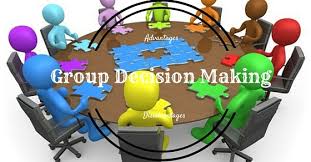Every organization consists of teams that face grave challenges – how to innovate faster, build better relationships with clients, respond to competitive threats, decide which products to invest time into and which ones to abandon. How do you decide the best direction?
Here are some tips that help teams make the best decisions together:
1. Get on the same page. In 1999 NASA had a mission to study the climate on the planet Mars. After 10 months of travel and 125 million, the spacecraft burned due to a navigational mistake, which was entirely preventable. It turns out, multiple teams were working on the project, one group used the metric system, while the other used inches, feet, and pounds. Some of the smartest people forget to check that both teams were using the same unit of measurement, and the consequences were catastrophic. Before you embark on the decision-making process, take some time to cover the basics, get the small details right, and properly understand the problem before deciding on something and be sure to level set on the expectations, processes, and tactics.
2. Take time for independent thinking. Spend some time individually to consider the problem and solutions so your ideas are not heavily influenced by anybody else’s. This will allow for more variety in creativity and innovation because there will be an even larger pool of plans in which to choose. A common mistake that many people make is that they may share their idea with their teammate and then ask for their opinion, but they have already tainted the person’s thinking and may create an environment where the person does not want to disagree with you, especially if you are the boss. This is why as a leader it is important to go last so you can hear as many raw ideas as possible for you to share your perspective.
3. Share in small groups. Form a series of small groups of 4-6 people within the larger team so all opinions can be put on the table and a consensus can be reached on the best way that the team can solve the problem. According to a Ted Talk by Mariano Sigman, a leading figure in the neuroscience on decision-making space, he shows how crowds are wiser when they can talk to other people in small groups. He ran an experiment where people provided an answer to a question about how tall the Eiffel Tower was and then they had a chance to discuss and debate. The result was that the average of the group was more accurate than the average of the individuals.
4. Share in big groups. Have a big group discussion where each team presents their ideas and then gets outside perspectives. It allows you to go for a “robust average” which gives a rough estimate of all the members’ answers while discrediting outliers. The old saying, “Two heads are better than one” is most true when you can extract each person’s untainted thinking first and then combine it with others to form even deeper insights.
5. Time for thoughtful disagreements. If three groups within the team put forth their ideas, they can exchange in the thoughtful back and forth, while others can ask questions for clarity and provide a challenge to the ideas. When you engage in quality discussions, people’s thinking can evolve and the best collective decision can be reached. Ray Dalio uses a technique like this. His goal is to attain an idea meritocracy, where the best ideas win out and have nothing to do with politics, personalities, status, or other influencers.
6. Decide on a tiebreaker. You may have strong ideas, energy, and evidence for two dominant positions, but in the end, you need to decide once you have carefully considered all sides of the discussion. Usually, when there is a deadlock in ideas, the leader should weigh in and break the tie. However, use the approach that works best for your team, if it is strictly by consensus, you can opt for that method.
7. Disagree and commit. Used widely by Andy Grove and Jeff Bezos, they believed that once a decision has been made, regardless if it was yours or not, as a team player, you need to be behind it and hope for its success rather than being indifferent or worse, aiming to sabotage the idea.
8. Use timeframes. To facilitate the decision-making process, it is helpful to use timeframes. For example, maybe you allocate a week for the first phase which is about gathering information and discussing openly. For the second phase, you can allocate the necessary time to make the decision. Without timelines, you could get stuck in endless discussions and fail to move to the execution phase.
There are many techniques that you can use to make the best group decisions. By having clear processes that allow each person to contribute their best input, hard decisions become a little less hard.
Quote of the day: “My opinion, my conviction, gains immensely in strength and sureness the minute a second mind has adopted it.” -Novalis, German Author and Philosopher
Q: How do your teams make decisions? What processes do you use? Comment and share below, we would love to hear from you!
As a leadership development and executive coach, I work with leaders to help them make hard decisions, contact me to explore this topic further.


